Industry outlook: Mobile Elevating Work Platforms
Next-generation models promise alternative power sources, greater capacities and even safer, more productive designs.
Mobile elevated work platforms (MEWPs) are undergoing quite a transformation post-ANSI AS92 standard update.
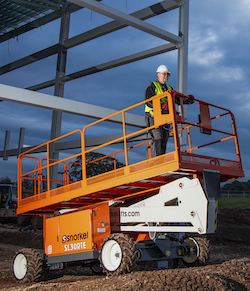 |
|
The new line of Snorkel large-deck rough-terrain construction scissor lifts offers three models with high capacities ranging up to 2,500 pounds, and four models with ultra-high capacities ranging up to 4,000 pounds. |
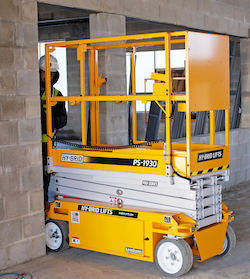 |
|
Hy-Brid Lifts, with its compact scissor design, can offer an ANSI-compliant higher rail that will fit through a standard doorway without folding down a rail extension. |
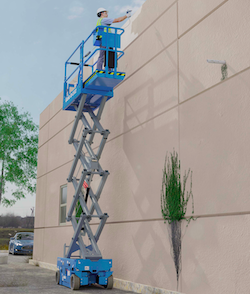 |
|
The Genie E-Drive line of slab scissor lifts feature an optimized AC electric drive system and a number of design improvements that can deliver up to a 35 percent reduction in lifetime maintenance costs. |
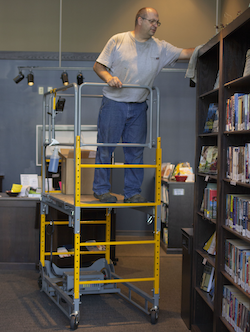 |
|
The Granite Power Snappy MEWP can be used where floor load capacities are a concern. They are easier to operate in tighter environments and can replace ladders for improved safety and productivity. |
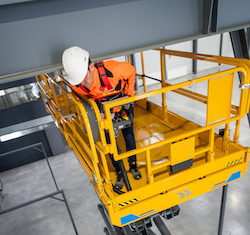 |
|
The HS4390 E and HS5390 E are the first scissor lifts to provide Haulotte’s Activ’Shield Bar secondary guarding device. In an entrapment situation, the operator is pushed toward the bar and the machine stops automatically. |
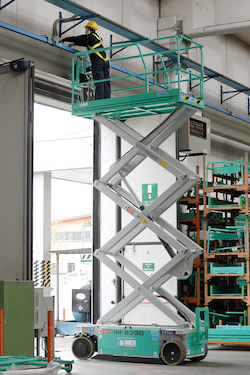 |
|
New Li-ion powered units are allowing use of MEWPs in areas where emissions or noise pollution previously prevented MEWP use. |
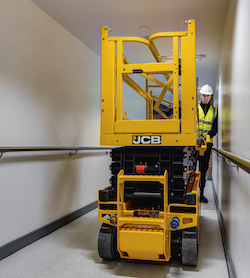 |
|
Telematics add the ability to track the location of your machinery as well as its health and current status. |
 |
|
Operators working on or near job sites such as bridges and overpasses with limited space will find the chassis ground-level technology can save time and money by eliminating excessive, costly job site preparation, such as grading to level surfaces. |
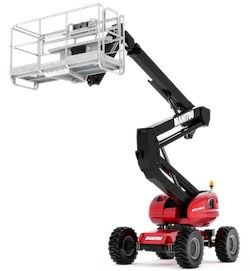 |
|
Manitou’s Easy Manager is now a standard feature on the majority of Manitou models. It is a web portal and mobile app that gives the owner actionable data to help with the day-to-day management. |
 |
|
Many OEMs have been producing ANSI A92-compliant machines since well before the requirements became official, putting them ahead of the game for testing and implementation. Equipment changes range from automated safety features to basic adjustments designed to keep workers safer. |
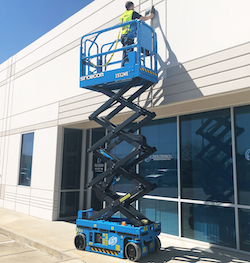 |
|
Many components in Sinoboom scissor lifts are maintenance-free, thus eliminating the need for users to conduct previously required daily checks. |
 |
|
Skyjack Next Generation models feature service-friendly components, more rigid scissor stack, easier-access emergency controls. The motor controls, relays and load-sensing are integrated into one system. |
 |
|
The Snorkel SR30Rt Speed Level li-ion powered boom lift can operate up to eight hours on a single charge. |
Today, user demands for electric units and greater capacity are causing manufacturers to take their designs back to the drawing board and reimagine how to lift workers, tools and materials quickly and safely.
 |
| Justin Kissinger, Hy-Brid Lifts |
Marketing Manager
Justin Kissinger
Hy-Brid Lifts
Demand for smaller units with high capacities and leak protection
Rental companies are constantly concerned with increased utilization, ease of operation, lower maintenance and safety; those are important aspects for end users as well. These are the factors that are driving MEWP design.
MEWPs are made for difficult jobs that are found in new construction, renovation or industrial applications. This often means containing mess, less noise and no damage to existing structures and flooring. Projects such as hospital renovations, new flooring with green concrete, sensitive flooring and even timber frame construction require a keen focus on floor loading to make sure floors are not damaged. In addition, lifts that are compact and highly maneuverable eliminate the risk of damaging walls or getting in the way of other subcontractors.
MEWP design will continue to push for more compact and light-in-weight units to accommodate these applications. Hy-Brid Lifts has traditionally offered the lowest floor loading on the market and it intends to keep that position, but the low floor loading and compact design must be balanced with functionality. Customers are looking for lifts with higher capacities that can handle more tools and supplies without triggering the load-sensing system. Hy-Brid lifts have always offered some of the highest capacities in the market and the drive continues to find ways to safely increase capacities.
Customers are driving the approach to hydraulic fluid containment. With MEWPs working in a variety of settings that have strict environmental restrictions, a safe and easy hydraulic fluid containment system is a key innovation. Hy-Brid Lifts offers an optional LeakGuard fluid containment system that provides 110 percent fluid containment. The system retains any leaking fluid in one, easily accessible tray, saving time and preventing spills. It’s an excellent alternative to diapers and other inconvenient and messy containment methods. Further, Hy-Brid lifts have only two hydraulic connections, minimizing leak risk.
New ANSI standards require higher rails for lifts to protect operators from falls. While the intention of this rule was beneficial, some designs have led to more headaches for operators. Many manufacturers now use folding rails to move through doorways, which require extra time for set up and takedown, are a less stable rail system and introduce operator pinch points. Hy-Brid Lifts’ design locates the scissor stack low in the base for a lower overall height and lower center of gravity. It also allows a higher railing height without pinch points or a shaky assembly and still allow transport through doorways.
The efficiency, productivity and safety gained from MEWPs is the biggest consideration for the rental market, providing an unbeatable work-at-height solution. Hy-Brid Lifts are designed for low maintenance and easy usability through an electric drive and steer system, robust rails and scissor stack and a two-year parts and labor warranty.
The new ANSI standards have sparked innovation. There are many differences between manufacturers and models now and this is creating more choices. New model choices can help diversify fleet offerings, which could create new rental markets.
Rental operations can increase demand by spreading awareness of the dangers of ladders and educating customers on the benefits of MEWPs. MEWPs help provide relief from falls, fatigue and repetitive action injuries that result from workers using ladders. This relief also comes with unmatched productivity. Contractors regularly report finishing jobs weeks ahead of schedule when using Hy-Brid Lifts over alternative methods due to their compact, highly maneuverable, safe and high-utility design. That return on investment is increased even more with features like non-folding rails and user-friendly fluid containment systems giving workers more efficiency, no matter where they need to go on the job site.
 |
| Mike Flanagan Genie Terex AWP |
Product Manager
Mike Flanagan
Genie Terex AWP
Electric drives gain traction
In 2020, Genie launched the E-Drive line of slab scissor lifts, which are equipped with an optimized AC electric drive system and a number of design improvements that can deliver up to a 35 percent reduction in lifetime maintenance costs compared to traditional slab scissor designs.
Additionally, because of the optimized design of the Genie E-Drive system, the battery delivers 30 percent more runtime per charge, reducing maintenance cost by 20 percent. Genie’s fully sealed AC electric drive motors are maintenance-free and are designed to withstand even the toughest job site conditions. With 25 percent gradeability, a redesigned tire tread, increased ground clearance and a 14-degree breakover angle, Genie E-Drive slab scissors are designed to deliver unmatched productivity on the job site while simplifying the load and unloading process and lowering the total cost of ownership.
The new MEWP standards were implemented in ANSI [United States] and CSA [Canada] markets last year are driving design changes in most MEWP products. As a result, all MEWPs sold in these countries will now have additional systems and slightly different specifications. For example, all scissor lifts will now require a platform load-sensing system, which has historically only been required in European markets. Additionally, scissor lifts designed under the new ANSI/CSA standards are likely to be heavier and are equipped with folding guardrails.
While MEWPs designed under the previous standards can still be used, there may be local or job site requirements that will make it necessary that rental companies offer products to meet the most recent standards.
Genie focuses on delivering quality products and services that deliver productivity on the job site while offering high ROI and lower total cost of ownership for our rental customers. Genie E-Drive scissors, for example, are designed to offer the significant improvement in runtime, gradeability and efficiency while reducing overall total cost of ownership. With Genie E-Drive scissors, rental customers can save up to 35 percent on maintenance costs over the life of the machine when compared with a traditional hydraulic drive design.
 |
| Jeremy Rupp Granite Industries |
Marketing Director
Jeremy Rupp
Granite Industries
Electric units eliminates leaks
One of the biggest advances in the world of MEWPs is the growing development of the all-electric drivetrain. Across the entire rental industry, there is an ever-increasing demand for manufacturers to offer battery-powered units. This has been true in the MEWP world as well.
Customers are seeing the clear advantages of electric power in all-new ways: no noise, no emissions and no leaking fluids. Of course, with the shift to battery power, there are ever-increasing customer demands for more power and longer battery life. Batteries are becoming bigger, stronger and lasting longer than ever before. Customers want the most out of their MEWPs and electric power answers that call.
When purchasing a new MEWP for rental, there are a couple things to consider. The first consideration is the versatility of the unit. How many different applications can this one lift be used? There are always a wide range of options from any MEWP manufacturer and finding the sweet spot in that line allows for the maximum reach to the customer base. The second thing to consider is the required maintenance on the unit. This can be an upside or downside, depending on the unit purchased. MEWPs require care and maintenance to ensure the unit is always in proper working order. Traditionally, gas-powered units offer lower upfront costs, but require more long-term maintenance when compared with electric powered units.
Rental centers can increase customer demand by offering smaller and lighter MEWPs. By offering smaller units, the rental center can meet the demands of a different type of customer. Heavy construction jobs generally require large and powerful MEWPs, but smaller jobs do not require the same type of MEWP. Light MEWPs, like the Granite Power Snappy, have the advantage of being able to be used where floor load capacities are a concern. They are also easier to operate in tighter environments.
General contractors, electricians and HVAC installers are looking for units that can speed up their job and improve safety. The lower upfront cost and lower rental price can appeal to these types of customers. The combination of reaching a new customer base and faster unit turns can result in higher profits and increased ROI.
 |
| Paul Jensen Haulotte Americas |
Product Manager
Paul Jensen
Haulotte Americas
Electric rough-terrain units gain popularity
Haulotte’s most recent rough-terrain scissor lifts incorporate the latest innovations and features that Haulotte offers in one rugged platform. The HS4390 E and HS5390 E scissors are the first 100 percent electric rough-terrain scissor lifts to join the Pulseo range of machines by Haulotte.
Knowing that batteries are one of the first and largest maintenance expenses faced by electric machine owners, Haulotte created the Activ’Battery Management system to care for and extend battery life. With features such as centralized water filling, operator messages to prompt charging at optimized intervals, accurate charge level and temperature sensing to optimize the charging curve and CAN Bus connectivity for real-time notifications, the Activ’Battery Management system saves money by extending battery life span and reducing hands-on maintenance hours.
In addition to monitoring and maintaining the battery, the newest scissors in the Pulseo range also include a removable Range Extender module. Using the 5.5kW, diesel-powered generator, the Range Extender can charge the batteries during machine operation, extending the already full-day duty cycle of the 48V battery pack until the work is done. The Range Extender also means the ability to work on a site that doesn’t have a reliable electrical connection for charging.
The new Haulotte scissors have been designed from the ground up to be a great addition to any rental fleet. Little design features that don’t seem like much begin to add up to decreased maintenance hours, faster repairs and lower TCO overall. A feature like mounting the access ladder to the wide-swing maintenance covers means technicians have full, easy access to every component that needs work or monitoring. Even the maintenance safety bar location has been repositioned so it is accessible from the ground, increasing technician safety during inspections and repairs.
The new machines also feature the Haulotte telematics solution, Sherpal. With Sherpal, rental stores not only know where their machine is located, the CAN Bus integration means they can monitor nearly everything about the machine, including fault codes and safety alarms. Diagnosing problems remotely may prevent expensive technician visits to the job site or minimize the cost by making sure the right parts are on the service truck to solve the problem with the first trip. Sherpal also stores inspection and maintenance records, giving owners documentation that can make a valuable contribution to resale value when it’s time to cycle the machine out of service.
Customers on a job site look to MEWPs to increase safety while increasing productivity; Haulotte Pulseo scissor lifts speaks directly to these customer requirements.
The HS4390 E an HS5390 E are the first scissor lifts to provide Haulotte’s Activ’Shield Bar secondary guarding device. The system provides the highest level of safety to aerial platform operators. In an entrapment situation, the operator is pushed toward the bar and the machine stops automatically. The large clearance space that Haulotte engineers call the Safety Gap, protects the operator from injury.
The Haulotte Activ’Lighting System uses headlights and lighting installed at strategic points to avoid operator glare. The operator can safely access, accurately control and identify obstacles and edges clearly in the working area.
To increase productivity, there’s a big advantage to the customer to have a machine from the Pulseo range on the job. Electric machines like these perform as well indoors as they do outside on rough terrain, so the HS4390 E and HS5390 E scissor lifts can likely stay productive on the job as it progresses. There is no need for additional delivery fees and possible delays as the project progresses from outdoors to indoors. Operators who have been comfortably using the machine since the beginning of the project don’t have to think about learning the operation of a different machine.
These scissor lifts can work with and without standard outriggers. Both models can drive while elevated to a height of 43 feet. The HS5390 E only requires outriggers to reach the top 10 feet of its range. Working without outriggers means spending less time resetting when moving from one work location to the next, especially when working along a long wall. Even though the outriggers are not required when working on level surfaces, they are ready to be deployed for use when the ground is sloped.
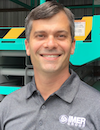 |
| Mark Choate Imer Group |
National Sales Manager
Mark Choate
Imer Group Access Division
Li-ion power opens doors
With all of the technological advances the equipment industry has seen in recent years, MEWP manufacturers have not been left behind. From advances in design to allow for safer use in different applications to new power sources to address emission concerns, Imer has continued to improve its MEWPs to address customer needs and safety.
New Li-ion powered units are allowing use of MEWPs in areas where emissions or noise pollution previously prevented MEWP use. Replacing a standard engine with a Li-ion battery pack provides the same level of power with none of the issues that come with Internal-combustion engines.
The lower maintenance needs of Li-ion power will help provide customers better return on investment.
There have also been the addition of telematics capabilities on MEWPs. Telematics kits, such as the Imerview system, allow for more control of assets. It enables the owner to monitor location, get information on usage and any alert any issues with MEWP operation.
As with any piece of equipment being brought into rental fleet, there are positives and potential negatives to MEWPs. One of the big downsides would be the inherent danger MEWPs may present if misused. With the adoption of ANSI-92 standards and the safety features in place on MEWPs, this danger has been mitigated but will never be entirely eliminated.
Proper training of rental staff and their ability to train the renter on correct use is vital.
When looking to add MEWPs to the fleet, rental companies need to remember there is not one universal MEWP to address all access needs; instead, it is important to identify the customer base you will be serving with your MEWP fleet and purchase the right model for that application.
With those considerations in mind, MEWPs are consistently in high demand with rental customers. Having the right units with the proper training and support can make MEWP one of the top ROI categories in your fleet. They can also open up a rental business to a customer base beyond general construction rentals. Arborists, facilities maintenance, material handling and municipalities all have regular access needs.
Rental companies that have MEWPs as part of their fleets can do a couple of things to make sure they are getting top ROI for these units. Start by having a diverse MEWP fleet that can address a number of different applications in different industries. The more problems the fleet can address, the more in demand those units will be.
Installing telematics, like the Imerview system, will help increase unit ROI. The loss prevention by having geo tracking on their units is just the first part. Having the ability to quickly and remotely diagnose any potential issues will save on maintenance costs.
It has been very exciting seeing the advances in MEWPs in the last 15 years. Imer will continue to introduce new models and I believe the sky is the limit for Imer Access.
 |
| Rebecca Yates JCB |
Material Handling Product Manager
Rebecca Yates
JCB North America
Telematics protects MEWP health
In all segments and types of construction equipment including MEWPs, the addition of telematic capability continues to be an important advance in technology. Telematics add the ability to track the location of your machinery as well as its health and current status.
This is particularly important to the rental industry because equipment comes in and out of the rental facility frequently and having up-to-date service and machine health information easily accessible allows the fleet owner to proactively manage machine downtime. Mobile phone apps can be used to manage MEWP fleets, allowing fleet owners and operators quick access to machine information.
As with any construction equipment, rental centers should pay special attention to safety standards and the machine’s ability to meet those standards. With MEWPs in particular, the new ANSI standards are currently in effect and it is important that all the units purchased new are compliant to protect both the operator and the rental company. MEWP extended warranties are something rental centers should consider. While they may be more of a cost upfront, they can help save on replacement part costs in the long run.
Rental centers can affect the demand for these units. If a rental center can offer a variety of sizes and models with a range of options, they’re able to satisfy a customer’s multiple needs
Similarly, rental centers that regularly perform preventive maintenance is s will easily increase the lifespan of the equipment, therefore increasing ROI on each unit. Fleet owners should ensure that equipment is periodically checked. Early identification of any pending issues allows them to be resolved as quickly as possible, decreasing downtime and increasing its ready-to-rent rate.
Fleet owners should consider purchasing options or accessories with the machine. With MEWPs, it is rarely only about the height but more about what the user can do at that height. While options and accessories may cost more up front, Rental centers can promote their use in specific applications, such as a generator that can run power tools or a welder.
The adage of ‘you get what you pay for’ comes into play with MEWP selection. A higher quality MEWP will last longer and increase ROI than a unit of lesser quality, so fleet owners should have a clear understanding of expected lifespan of the machine they’re purchasing. That will help ensure budgetary decisions are based on long-term goals.
 |
| Ignacy Puszkiewicz JLG |
Senior Director of Future Technology and Industrial Design
Ignacy Puszkiewicz
JLG
Smarter chassis opens options
Access equipment designs are going through a significant transformation. This new generation of machines looks and operates very differently. It’s no longer about general specification updates; it’s about combining innovation with technology to solve the most common job site challenges, like working on uneven or inclined terrain.
Some OEMs have focused on developing products that reach farther and higher, while others have advanced the machine’s control system technology to enable the equipment to work on steeper slopes.
While these advances are good and have a place in the market, JLG leaders believe that the access industry’s future will be for OEMs to develop practical technology solutions that are nearer to ground level, introducing the concept of a smarter chassis.
Smarter chassis technologies will benefit not only general construction applications on undeveloped surfaces but also work on improved surfaces where infrastructure is already established. For example, technology can help operators working in city centers that want to get closer to buildings but can’t because of the imbalance in height between the streets, curbs and sidewalks.
Also, operators working on or near job sites such as bridges and overpasses can be extremely limited on space because of ongoing traffic or water obstacles could benefit from using machines with advanced chassis technology. This type of ground-level technology could also save a significant amount of time and money because it would eliminate the need for excessive, costly job site preparation, such as grading to level surfaces. It would also eliminate the need for cribbing so these machines could be used on more types of job sites. This technology would allow machines to work closer to buildings with less positioning while providing operators with a more comfortable, stable feeling while operating in rugged conditions.
As OEMs consider what solutions they can offer that address working in varying terrain, they must make sure that the machine is engineered to handle the capabilities of advancing technologies.
For example, when developing smarter chassis systems, OEMs need to make sure that the machine can drive/move while elevated and assure the tires remain in contact the ground. The machine’s drive system also has to offer smooth operation in all conditions. The machine’s control system needs to actively monitor and control the machine’s dynamics during operation, such as platform movement. In addition, the machine must be able to communicate back to the operator what it’s doing, as well as what the limits of the machine’s operations are under the present conditions.
Several recent developments in machine chassis technology have been developed that now offer operators new ways to be productive when working on uneven terrain. For instance, variable-tilt and self-leveling technologies are designed to adjust a machine’s capability under certain ground or surface conditions. Variable-tilt technology is currently available on JLG scissor lifts. It focuses on modifying the machine’s lift height, or work envelope, based on the tilt of the chassis.
Self-leveling technology, soon available on JLG boom lifts, will adjust the lift’s chassis to match the ground conditions rather than adjust the machine’s capability to ground conditions.
As the adoption of new technologies that improve operations’ efficiency and safety gains momentum in the access industry, OEMs must also make sure these machines adhere to the current industry standards. In North America, that means new access equipment must comply with the updated ANSI A92 [United States] and CSA B354 [Canada] standards, which went into effect on June 1, 2020.
The Machine Design sections in the ANSI and CSA standards — ANSI A92.20 & CSA B354.6, respectively — specifically addresses the design, calculations, safety requirements and testing methods of MEWPs, which significantly influence how new technology is incorporated into these machines.
For example, these machines are now required to have load-sensing capabilities, which actively monitor load, sound an alarm and interrupt normal operations if overloaded. They must also have a tilt sensor system that will alarm, as well as disable boom and drive functions, if the incline surpasses the slope limit.
Compliance is critical because these standards reduce safety hazards and prevent lost time. However, changes such as load and tilt sensing will require operators to do more planning ahead of work at height to make sure that it’s possible to complete it with the equipment ordered for the job. Operators will need to carefully consider the application when choosing a MEWP for the job. Machines with smart chassis technology will allow operators to work without extra pre-planning.
Technological advances will continue to transform the access industry to maximize productivity and enhance safety. As demand for new technology increases, MEWP owners/rental centers must be ready to respond with modern equipment fleets.
These are step changes for the industry. The technologies will truly transform how people work at height by increasing productivity and enhancing safety best practices. As technology evolves, the idea is that these innovations will not only change how the industry works today, but that these advances will be the way forward, too.
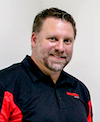 |
| Brian Rabe Manitou |
Product Marketing and Training Manager
Brian Rabe
Manitou
Matching new models to customer needs
Manitou has been developing electric MEWPS and it has two AETJ models in its line. As customers are showing more interest in this technology, there are opportunities and challenges that rental centers must consider before bringing them into the rental fleet.
First, it’s important the machine can reach the height that customers want and need and meet the ANSI AS92 standard. The new units should be easy to operate with an intuitive control panel and that new models are easy to service. Operators and owners need to perform routine maintenance on any MEWP to ensure the safety and smooth operation of the machine. Some items that should not be overlooked include greasing the axles and steering joints to prevent premature or excessive wear.
Manitou offers the latest generation of onboard diagnostic tools on its models, which can help maintain equipment. Manitou’s Easy Manager is now a standard feature on the majority of Manitou models. Easy Manager is a web portal and mobile app that gives the owner actionable data at his or her fingertips to help with the day-to-day management. This feature makes it easy for the owner to complete preventive maintenance, improve machine security, increase uptime and provide better customer service. All of this allows the customer to concentrate on his or her core business and lets the owner or rental company manage the life cycle of each machine.
Rental centers are increasingly finding that it’s valuable to work with a trusted manufacturer or dealer that has strong customer support and parts availability. It’s best to look beyond the sticker price and consider the total cost of ownership and potential resale value.
 |
| Mitch Fedie Pettibone |
Marketing Manager
Mitch Fedie
Pettibone
Load sensing creates training need
The new ANSI standards for mobile elevating work platforms (MEWPs) are in effect and scissor lift technology on new models has adapted as a result. Many OEMs have been producing ANSI A92-compliant machines since well before the requirements became official, putting them ahead of the game for testing and implementation. Equipment changes range from automated safety features to basic adjustments designed to keep workers safer.
For example, chains can no longer be used as doors, with self-closing, self-catching entry gates becoming the new standard. Rail guards and toe guards must now be higher, which has forced more scissor lift rails to have fold-down features to fit through doorways. However, some units are still compact enough to not need fold-down rails.
The biggest changes equipment operators will experience relate to load and machine tilting restrictions that will completely stop the machine. Most OEMs have introduced load-sensing systems that use a hydraulic pressure transducer. Based on the rated weight capacity and corresponding pressure range, a scissor lift will cease all functions if the weight limit is exceeded.
These weight capacities apply to the total weight of any operators along with their tools and materials. Rental centers need to make sure that customers understand this restriction.
To help avoid tipping over, scissor lift tilt ratings have been established. For Pettibone machines, those limits are three degrees for front and back incline or decline, and 1.5 degrees for left-to-right tilting. If tilt levels are exceeded, the machine automatically cuts out. This means that even something like driving over a board while positioning a scissor lift could trigger the tilt sensor and stop the machine.
Telematics continue to grow in popularity, especially as a tool for remotely diagnosing minor machine issues before they grow into larger problems. This technology can increase ROI by ensuring that maintenance is up to date and by eliminating certain field-service calls. Being able to monitor equipment locations or completely shut down a machine if a critical alert is received are also important financial benefits of a telematics system.
Rental houses looking to bring new or used MEWPs into their fleets will need to ensure they are compliant with the latest ANSO standards. ANSI standards make it imperative that OEMs, dealers and rental operators educate customers about new scissor lift safety measures. To accomplish that, proper staff training will become more critical.
Regulations are now stricter for assessing work areas for potential hazards. Anything that could cause the machine to tip or not function correctly should be addressed before starting work. Users may also need to anticipate certain conditions, like wind impacts. Even if operating within the 28 mph windspeed rating, a scissor lift could become vulnerable to tipping if a worker is lifting a sheet of drywall that could suddenly act as a sail.
All operators will go through certified training for MEWPs, but there is also a new familiarization aspect where personnel on the ground must be available for emergencies; specifically, this person must be familiar with the emergency lowering lever to get the platform down if it malfunctions.
Under ANSI A92, scissor lifts must be inspected annually. Users should also do daily pre-start inspections. Batteries should be in good working condition and topped off with distilled water. When replacing, use OEM-approved batteries, remembering that battery weight may impact the machine’s overall stability.
Most OEMs have met the new ANSI standards with intuitive adjustments. Still, those looking to purchase MEWPs and rent them out should give ample consideration to how the new standards will impact their business.
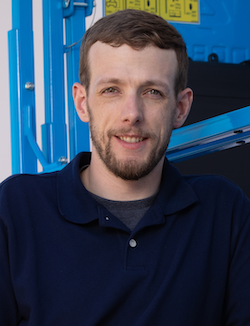 |
| Trevor Collins Sinoboom |
Service Manager
Trevor Collins
Sinoboom North America
Lower maintenance units advance
Advances are always at the forefront of Sinoboom engineers’ minds when designing machines. For example, improvements in battery technology, which includes battery monitoring, smart charging and telematics give customers insight into day-to-day operating and charging habits.
All of these advances help reduce the cost of ownership and increase ROI, especially when battery replacement is one of the biggest costs in lift operation.
On-board machine diagnostics is also advancing. When a technician needs to gather machine information or troubleshoot a fault, the ability to do it all on-board is essential. This frees technicians of the need to carry a laptop and connecting cable. Bottom line, it allows technicians, especially those in the field, to be more efficient.
Lastly, advances in technology give the user more confidence in machine operation. As MEWPs evolve, users can see operator information and machine feedback based on that particular machine’s functions. An intelligent interface, such as those on Sinoboom MEWPs, are effectively the eyes and ears of the machine, making its operation intuitive for ordinary users. User-friendly communication provides timely machine status updates and quick failure diagnosis helps avoid a long wait for diagnostic professionals to arrive.
When a customer wants to introduce a new MEWP into their fleet, there are many aspects to take into consideration. Machine operation and design are the most important. Many different operator controls and machine configurations are present in the vast MEWP market. Users may have brand loyalty due to their comfort level with that particular brand’s controls. Having familiar machine controls is essential in a new MEWP, which makes a purchase decision that much easier.
Parts stocking is another crucial aspect of bringing in new MEWPs to a rental fleet. Introducing a machine with industry-standard parts from well-known and reliable manufacturers allow for uniformity in parts, thus allowing customers to carry multiple brands.
Reliability is always a concern when purchasing any new brand of product. With construction equipment, it is not a matter of if, but when a machine will need repair. The work conditions these machines are often put through tests their reliability. But reliability goes beyond the machine and to the manufacturer’s support system. Customers want and deserve reliable manufacturer support.
Many components in Sinoboom scissor lifts are maintenance-free, thus eliminating the need for users to conduct previously required daily checks. A couple of examples are the self-lubricating bushings and maintenance-free batteries. While these items are still regularly inspected, it takes away some of the day-to-day responsibility. It also prevents user-induced failure, such as lack of lubrication or low battery water levels.
 |
| Malcolm Early Skyjack |
Vice President of Marketing
Malcolm Early
Skyjack
Operator education takes on more importance
The face of MEWP (formerly AWP) has changed dramatically since Skyjack first started manufacturing scissor lifts more than 30 years ago. While at first glance the bones look similar to their historical counterparts, advances have been made in every part of a MEWP. Just within the past two years, Skyjack has made advances to nearly every part of a scissor lift in its Next Generation models. These advances were made in conjunction with new ANSI standards and were designed to quell some of the top pain points from rental companies.
Key changes to our Next Generation scissor lifts include:
- Newly designed upper control box with integrated shroud and service-friendly components
- Increased rigidity on the scissor stack to improve operator comfort while working at height
- Single location emergency lowering integrated into the swing-out tray – no more access rod
- Enhanced pothole protection system, improving ground clearance by up to 45 percent
- Advanced Skycoded control system that combines the functionality of motor controller, relays and load-sense into one system
- Skycoded diagnostic display that provides plain-language machine troubleshooting, which removes the need for a separate handheld calibration unit
In February 2021, Skyjack also revitalized its 40- and 60-foot booms to improve customers’ ROI. those improvements include:
- Significantly fewer sensor and emission regulation components to minimize associated downtime
- Reduced fuel usage through reduced engine size
- Eliminated downtime related to aftertreatment components clogging in colder climates
- Eliminated dealing with customer issues on active regeneration
- Eliminated expensive diesel oxidization catalyst (DOC) or diesel particulate filter (DPF) maintenance or replacement
- Reduced engine OEM intervention and loss of uptime
- No reliance on ultra-low sulfur fuel, which reduces costs and improves resale options
In addition, many companies, including Skyjack, are finding ways to incorporate telematics solutions to help further benefit the ROI for rental companies. Skyjack’s Elevate Live is standard on all equipment as of 2020 and provides operators and site staff with serial-specific machine information like Quickstart Guides and Pre-Use Inspection Guides at their fingertips. If a machine has Elevate telematics installed, it also has access to battery levels and CAN Bus information where applicable.
When rental companies contemplate updating their fleets with new equipment, the most important thing to keep in mind is operator education – especially when it comes to new ANSI 92.20 design standards. Load sensing is now mandatory on all MEWPs, which is something new for the North American market and may take some time for operators to understand. Partnering with OEMs who readily provide educational material for both rental companies and end users, like Skyjack’s materials on skyjack.com/ansi-update, is a great way for rental companies to get information out to job site staff.
Actively promoting features that make tasks easier for job site staff is an excellent way rental companies can help increase demand and utilization on newer units. For example, Skyjack SJ63/85 AJ booms, standard features such as Speedyreach allows the operator to transition from full height to ground level for restocking without lowering the riser section. That means less maneuvers to get back to height and back to work faster.
Advanced systems such as the new Skycoded diagnostic display reduces the amount of time spent troubleshooting; Elevate Live reduces service calls and on-site visits by providing operators with all the necessary machine information right from site.
A single advance on its own does improve a MEWP, however it’s the combination of advances, which have been implemented through data-driven design, is what sets Skyjack MEWPs apart. The Skyjack team uses information about how machines are actually used on site, takes that information to the Skyjack design teams and then implements those changes to drive real value for rental companies.
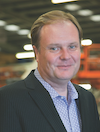 |
| Matthew Elvin Snorkel |
CEO
Matthew Elvin
Snorkel
Increased lifting capacity a reality
To increase job site productivity and use MEWPs for a greater range of applications, operators have been requesting increased lifting capacities for some time. Recently, multiple manufacturers, including Snorkel, have introduced enhanced lifting capacities on existing models and are focusing on this in the design and development of new MEWPs.
At Snorkel, its mid-size telescopic boom lift line has been enhanced with greater lifting capacities. The Snorkel 400S, 460SJ, 600S, 660SJ and 600S and 660SJ All-Terrain models have been fitted with a newly designed, globally-compliant jib boom. Measuring 5 feet 6 inches, the new jib boom reduces the stowed length of the unit for ease of transportation while enabling higher lifting capacities.
These new models now deliver a maximum platform capacity of 1,000 pounds with a restricted working envelope and 600 pounds unrestricted. Developed in response to customer demand, the higher lifting capacities enable workers to carry additional tools and materials to the work area, increasing job site productivity.
Snorkel is also focusing on capacity in the development of its new models. The new line of Snorkel large-deck rough-terrain construction scissor lifts offers three models with high capacities ranging up to 2,500 pounds, and four models with ultra-high capacities ranging up to 4,000 pounds.
From a global perspective, increasing regulations on job site emissions and noise are driving demand for MEWPs with alternative power sources to combustion engines. Snorkel is developing electric power alternatives for many of its mid-size, traditionally diesel-powered MEWPs; to date it has nine Li-ion battery powered lifts available.
This includes five compact rough-terrain scissor lifts, two sigma-boom Speed Level lifts, a 46-foot articulated rough-terrain boom lift and a compact rough-terrain telehandler. Utilizing efficient, maintenance-free Li-ion battery packs with integrated battery management system (BMS), these lifts deliver powerful rough-terrain capabilities and hold sufficient charge for normal driving and elevating operations during a 6 to 8 hour shift. When compared to the diesel equivalent, these lifts deliver 100 percent reduction in emissions, a 62 percent noise reduction, and a 93 percent reduction in service costs.
Investing in new MEWP products can be advantageous for rental companies as they can provide a point of differentiation, at least initially until the new product becomes more widely available, and may offer new safety and/or productivity benefits which they can highlight to their customers. Additionally, newer product designs may benefit from improvements in serviceability and lower maintenance costs vs. legacy designs.
However, new products, and particularly when introducing a new brand of products, may require additional training for the rental company sales, service and delivery personnel. For example, the customer familiarization process might be different than other MEWPs in their fleet, and from a service perspective, both store-based and field technicians will need to be trained on repairs, troubleshooting and maintenance procedures for the new product.
The rental company may also need to invest in spare parts to support the new product, and in some cases, depending on the size and weight of the equipment, may need to adapt or expand its delivery vehicle fleet.
The introduction of new products can take time, and generally requires a partnership approach between the rental centers and the equipment manufacturer to educate renters on new features and capabilities and the benefits they can bring in the real-world environment.
Rental centers need to utilize marketing opportunities to highlight new products, as well as educate their sales teams who can highlight these new products to their customers. In terms of increasing ROI, rental centers need to evaluate the customer benefits of the new equipment to determine the correct rental rate.
New products with new features that solve customer issues may be able to command a higher rental rate than similar products without the new features.
###
This article originally appeared in the May-June 2021 issue of Pro Contractor Rentals magazine. ©2021 Urbain Communications LLC. All rights reserved.










